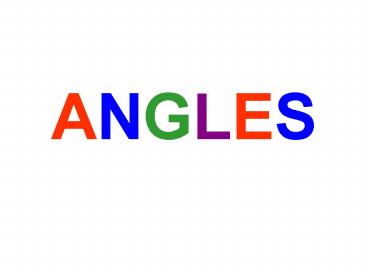ANGLES - PowerPoint PPT Presentation
1 / 19
Title: ANGLES
1
ANGLES
2
- You will learn to classify angles as acute,
obtuse, right, or straight.
3
What is an angle?
- Two rays that share the same endpoint form an
angle. The point where the rays intersect is
called the vertex of the angle. The two rays are
called the sides of the angle.
4
- Here are some examples
- of angles.
5
- We can identify an angle by using a point on each
ray and the vertex. The angle below may be
identified as angle ABC or as angle CBA you may
also see this written as ABC or as CBA. The
vertex point is always in the middle.
6
Angle Measurements
- We measure the size of an angle using degrees.
- Here are some examples of angles and their degree
measurements.
7
Acute Angles
- An acute angle is an angle measuring between 0
and 90 degrees. - The following angles are all acute angles.
8
Obtuse Angles
- An obtuse angle is an angle measuring between 90
and 180 degrees. - The following angles are all obtuse.
9
Right Angles
- A right angle is an angle measuring 90 degrees.
- The following angles are both right angles.
10
Straight Angle
- A straight angle is 180 degrees.
11
Adjacent angles are side by side and share a
common ray.
15º
45º
12
These are examples of adjacent angles.
45º
80º
35º
55º
50º
130º
85º
20º
13
These angles are NOT adjacent.
100º
50º
35º
35º
45º
55º
14
When 2 lines intersect, they make vertical angles.
75º
105º
105º
75º
15
Vertical angles are opposite one another.
75º
105º
105º
75º
16
Vertical angles are opposite one another.
75º
105º
105º
75º
17
Vertical angles are congruent (equal).
30º
150º
150º
30º
18
Supplementary angles add up to 180º.
40º
60º
120º
140º
Adjacent and Supplementary Angles
Supplementary Anglesbut not Adjacent
19
Complementary angles add up to 90º.
30º
40º
50º
60º
Adjacent and Complementary Angles
Complementary Anglesbut not Adjacent































